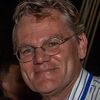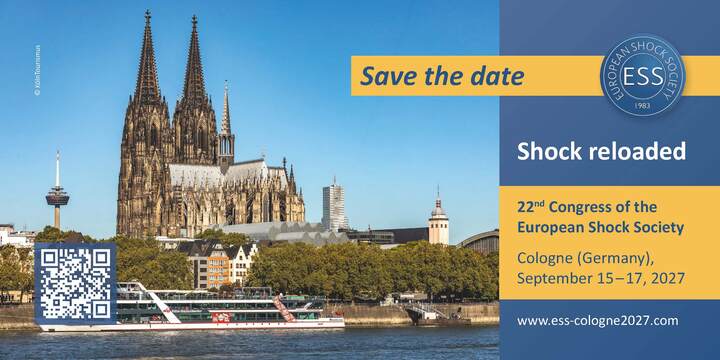Welcome
The European Shock Society
The mission of the European Shock Society:
The primary objective of the European Shock Society is to advance understanding of the pathophysiology and to improve treatment of shock, trauma and sepsis and/or allied disciplines.
The aforementioned shall be achieved by:
- Promoting basic and clinical sciences and encouraging the exchange of knowledge and ideas via scientific meetings and conferences, newsletters and/or personal communication among ESS members and beyond.
- Encouraging professional education and mentoring of the young investigators in shock, trauma, and sepsis.
A message from the President
It is with pride and humility that I take on the role of President of the European Shock Society (ESS). I would like to take this opportunity to express my sincere gratitude to all members of the society for their trust and respect. I am taking over from Borna Relja (Ulm, Germany), who has confidently steered the society over the last two years of her presidency and has had a significant impact on the society with her ideas and commitment. The 21st ESS Congress in Dubrovnik (Croatia), which has just come to a very successful end, is a reflection of her personality. Never before in the history of the ESS have so many prizes been awarded to young, motivated and committed young scientists as this year. Particularly noteworthy in this context is the Tomasz Skirecki Memorial Award, which was presented to five young scientists and included not only a travel allowance but also the annual ESS membership fee. In terms of congress content, it should be noted that almost half of all presentations were given by female scientists, and over 60% of the speakers were under 45 years of age! The tandem concept, which was introduced for the first time this year and aimed to integrate young scientists as session chairs, was perceived as very successful. From my personal perspective, one highlight of this year's congress was undoubtedly the summer school (FOR5417), organised independently by young scientists and supported by the German Research Foundation (DFG), which featured a variety of hands-on sessions on the topic of acute care for critically injured patients with a strong focus on current research concepts in the field of trauma and sepsis. Together, we experienced a scientifically highly demanding and competitive ENIAC competition with a happy female winner. The decision on the award was extremely close, and I would therefore like to emphasise once again the quality of the five papers that were shortlisted for the final round.
At the working level of the ESS several changes had to be voted upon. I wholeheartly welcome Sina Coldewey (Zurich/Switzerland) as President-Elect for the term 2028-2029 and Anna Herminghaus (Düsseldorf/Germany) as the new Treasurer. With the tragic passing of Tomasz Skirecki at the beginning of this year, the ESS family lost not only a highly valued person, colleague and friend, but also an extremely active member of the Society, most recently in the role of Councillor. Two other Councillors, Stefanie Flohé and Markus Huber-Lang, were not eligible for re-election, and I would like to warmly welcome Antigoni Kotsaki (Athens, Greece), Attila Rutai (Szeged, Hungary) and Christian Bergmann (Ulm, Germany) as new Councillors of the ESS. Together with Brendon Scicluna (Msida/Malta) and Federico Aletti (Sao Paulo/Brazil) we now have a five strong Councilors to support the Society.
After the congress is before the congress, and my team and I have already begun planning for the 22nd Congress of the European Shock Society, which will take place from 15 to 17 September 2027 in Cologne, Germany. May I ask everyone to already make a note of this date in their calendars. Following the successful congresses in 2008 and 2015, the ESS family will now meet for the third time in Cologne, and it is a great honour for me to welcome you back to our beautiful city on the Rhine river in two years time from now. Until then, my aim is to contribute to further advancing the Society in terms of content and structure, with a particular focus on the closer integration between basic research and clinical application. I cordially invite you to join us on this journey and to work together towards our common goals. Next year, we will already have the unique opportunity to present European shock research to the international community at the joint congress of the US Shock Society and the International Federation of Shock Societies (IFFS) in Las Vegas (USA) as a key driver of global scientific advancement in the field. ‘The future begins now!’
With warm regards

Marc Maegele
(ESS President 2025-2027)

The ESS has created a resource for ESS members who are looking for networking opportunities and would like to share their areas of interest with other experts.
This information will be stored in our members' database which will be made publicly available on the ESS website for other professionals to view. Email addresses will not be published.
If on browsing the database you would like to make contact with an individual, please use the contact form at the bottom of each member's page. A request will then be forwarded to the individual on your behalf.
Forthcoming ESS Events
Other Events
International Symposium on Intensive Care and Emergency Medicine (ISICEM)
25th European Congress of Trauma and Emergency Surgery (ECTES)
Newsticker
![]() SARS-COV-2/COVID-19: Evolving reality, global response, knowledge gaps, and opportunities (3.27 MB)
SARS-COV-2/COVID-19: Evolving reality, global response, knowledge gaps, and opportunities (3.27 MB)
![]() The 2030 World Sepsis Declaration.pdf (474 KB)
The 2030 World Sepsis Declaration.pdf (474 KB)
![]() Reducing the global burden of sepsis: a positive legacy for the COVID-19 pandemic? (486 KB)
Reducing the global burden of sepsis: a positive legacy for the COVID-19 pandemic? (486 KB)
![]() Sepsis Fact Sheet (1.47 MB)
Sepsis Fact Sheet (1.47 MB)
![]() ESS Statement of Support to the Ukraine.pdf (210 KB)
ESS Statement of Support to the Ukraine.pdf (210 KB)
6th Edition of the ABC Trauma guideline - endorsed and co-authored by ESSLink to full text
Minimum Quality Threshold In Pre-Clinical Sepsis Studies (MQTIPSS): An International Expert Consensus Initiative for Improvement of Animal Modeling in Sepsis
![]() MQTiPSS Executive Summary - SHOCK 2018.pdf (169 KB)
MQTiPSS Executive Summary - SHOCK 2018.pdf (169 KB)
Specific details to the individual MQTiPSS points:
Part I:
https://www.ncbi.nlm.nih.gov/pubmed/?term=10.1097%2FSHK.0000000000001243
Part II:
https://www.ncbi.nlm.nih.gov/pubmed/?term=10.1097%2FSHK.0000000000001242
Part III:
https://www.ncbi.nlm.nih.gov/pubmed/?term=10.1097%2FSHK.0000000000001209
















